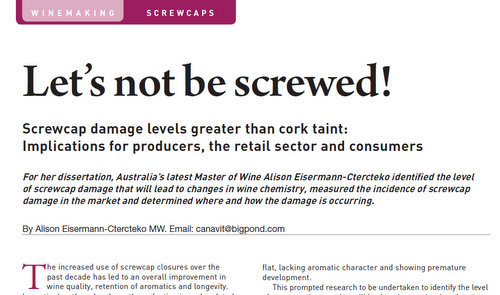MW dissertation claims that screwcaps cause more wine damage than cork
The rise in screwcap use in Australia since 2000 has been remarkable. Now they are by far the majority closure, for fine wines as well as more commercial ones. But a Masters of Wine (MW) dissertation by Alison Eisermann-Ctercteko, which has been published in Australian trade publication Wine and Viticulture Journal, presents evidence that is claimed to show that screwcaps cause more damage to wine than cork.
Eisermann-Ctercteko surveyed 22 retail outlets, most in the Sydney area, and examined some 11 500 bottles. The level of damage, if any, was graded on a five-point scale. Wines sealed with damaged screwcaps were then analysed for free and total sulfur dioxide (SO2) and browning (absorbance at 420 nm). Loss of free SO2 and browning are both signs of oxidation.
The results of these studies were alarming. The overall physical damage level of the screwcapped wines was 26%. 8.2% of screwcapped wines were damaged enough for significant changes to be detected in both browning and free SO2 levels.
In addition, 7.2% of screwcaps were applied incorrectly, or there was a fault in the application, but most of these defects were merely cosmetic.
She also found that printed screwcaps were more likely to show damage than plain ones. The Stelvin Lux, with its internal plastic seal, showed very little damage, but this closure is more expensive.
‘Screwcap damage is a significant issue and shown to be surprisingly high in retail at a level of 8.2% of screwcapped bottles,’ says Eisermann-Ctercteko. ‘This is greater than the previous industry-wide problem of cork taint which led to the rapid change in closure type. This requires immediate resolution, as these levels are unacceptable.’
Screwcap supporters will argue that cork taint is more of a problem than the levels of oxidation seen in these wines because cork taint renders a bottle undrinkable. However, producers will be alarmed that 8% of their bottles are showing signs of oxidation because of the closure.
NOTE ADDED LATER: I have seen the original dissertation, and I disagree with the interpretation of the data. You can read my comments here
October 24th, 2013 | Tags: closures, wine science | Category: wine science
Origin information: Wineanorak.com
